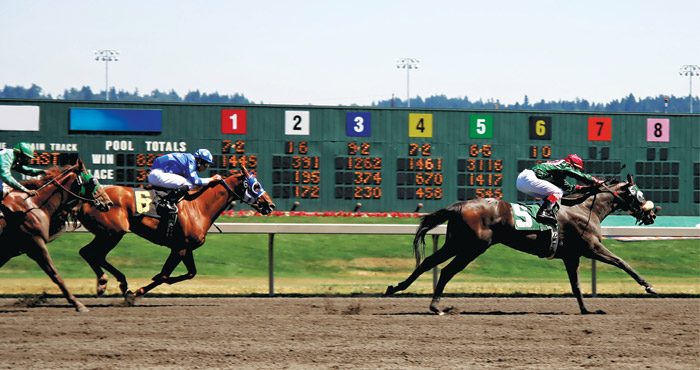About 20 seconds into the 2018 Belmont Stakes, Justify took the lead and never looked back, locking up the Triple Crown. The next month, the 3-year-old retired from racing with only 6 starts — and 6 wins — to his name.
Justify isn’t a special case. Horses have been trending toward racing and retiring at a younger age, as owners hope to claim victory sooner rather than later, according to Katie Lamb’s opinion piece in The Toronto Star that discusses why horse racing is a danger to horses.
Lamb writes that breeders are impatient, so they work to produce horses that are early bloomers, ready to race at 2 years old. And they’re making a killing: “The value of stallions who produce those quick starters skyrockets, making shareholders rich(er),” notes the freelance writer who has contributed numerous horse racing pieces to various publications. The tradeoff of stamina for speed might be lucrative to horse breeders and owners, but the horses themselves are seemingly the only party not benefitting from it.
Dr. Larry Bramlage’s opposing piece for The Star (run along with Lamb’s) argues that we can do everything in our power to make racing as safe as possible — no whips, safe medication, proper care, etc. — but at the end of the day, running and competing are what horses live to do.
The International Equine Veterinarian Hall of Fame member says that multiple organizations within the horse racing industry are working to learn all they can about horse safety in order to be of better practice on and off the track.
“I have performed surgeries on Thoroughbreds for 40 years, due to injuries that happen in competition and in the field,” Bramlage writes. “I can say with the highest degree of confidence that we’re not forcing racehorses into danger at the track. We are simply privileged to be participating in something they absolutely love to do. But in exchange for that privilege, we all carry the responsibility of making it as safe as possible for them when we watch. The industry accepts that responsibility and makes it the highest of priorities.”
You May Also Be Interested In...
Why Equine Bones Break and Tendons Rupture
Barbaro’s injury at the 2016 Preakness Stakes and the heroic attempts to save him by the New Bolton Center at University of Pennsylvania School of Veterinary Medicine drew a lot of attention to the question of why so many young performance horses suffer from broken bones and ruptured tendons. Are these kinds of injuries inevitable? Should we give up trying to solve this problem? Read now »
Both Lamb and Bramlage raise a similar point in the inherent nature of the sport: injuries happen.
Bramlage compares a top horse to any top athlete — bodies break down, and the risk of an injury is omnipresent. Lamb uses more specific science to call into question the risk of racing, and she’s echoed by Dr. David Ramey in a blog post on horsenetwork.com. A 1,200-pound animal running at 40 miles per hour creates a force more than twice that of the amount of force it takes to snap a human’s femur bone, Ramey deduces. It’s not just a matter of force, though.
“The muscles and ligaments and tendons that support his limbs are fatigued,” Ramey writes. “The bone may have some unrecognized damage from previous training sessions. He takes a funny step, or he trips. All of a sudden, this damaged bone, supported by fatigued tissues, is subjected to a massive amount of stress from an unusual direction. Under such circumstances, the horse’s leg can quite simply explode.”
As with any equine athletic event, there is a risk of accidents and injury — regardless of the lengths that humans take to prevent them.
“Ultimately, people are going to have to decide if any number of horse-racing associated deaths are tolerable,” Ramey writes. “The steps being taken to make racing safer are long-overdue and most welcome (at least in my opinion). But it’s unreasonable to think that horse racing will ever be perfectly safe.”







